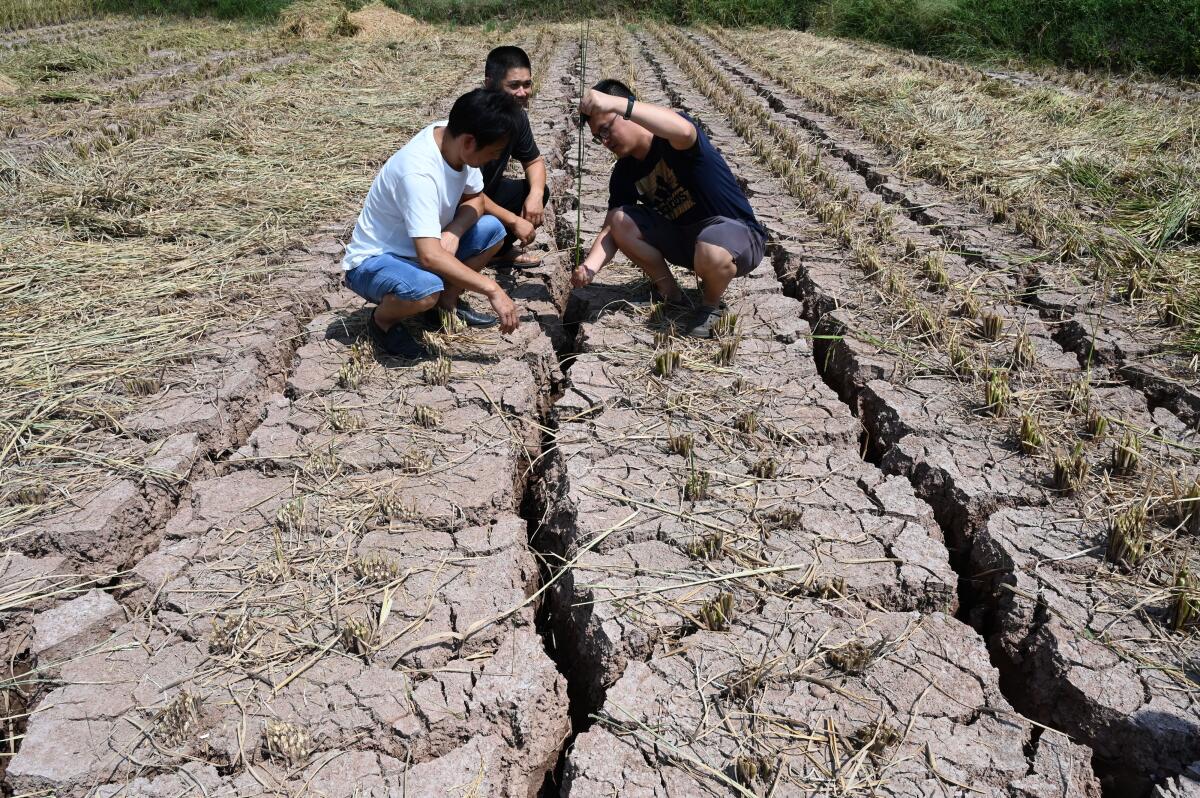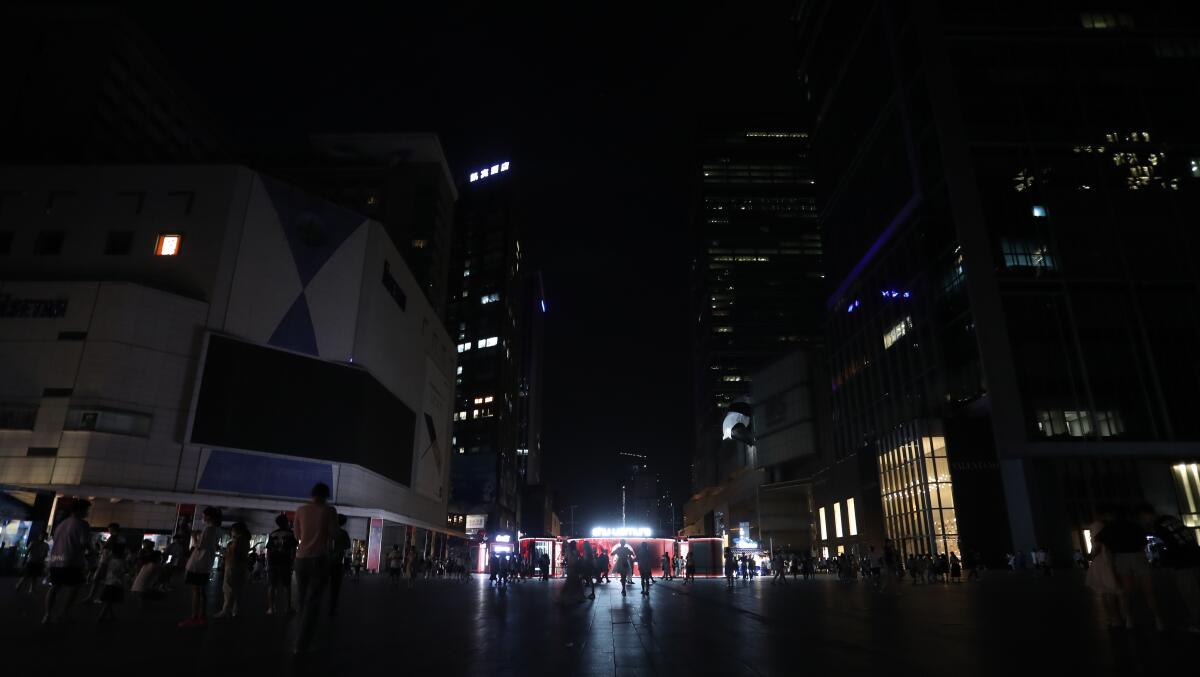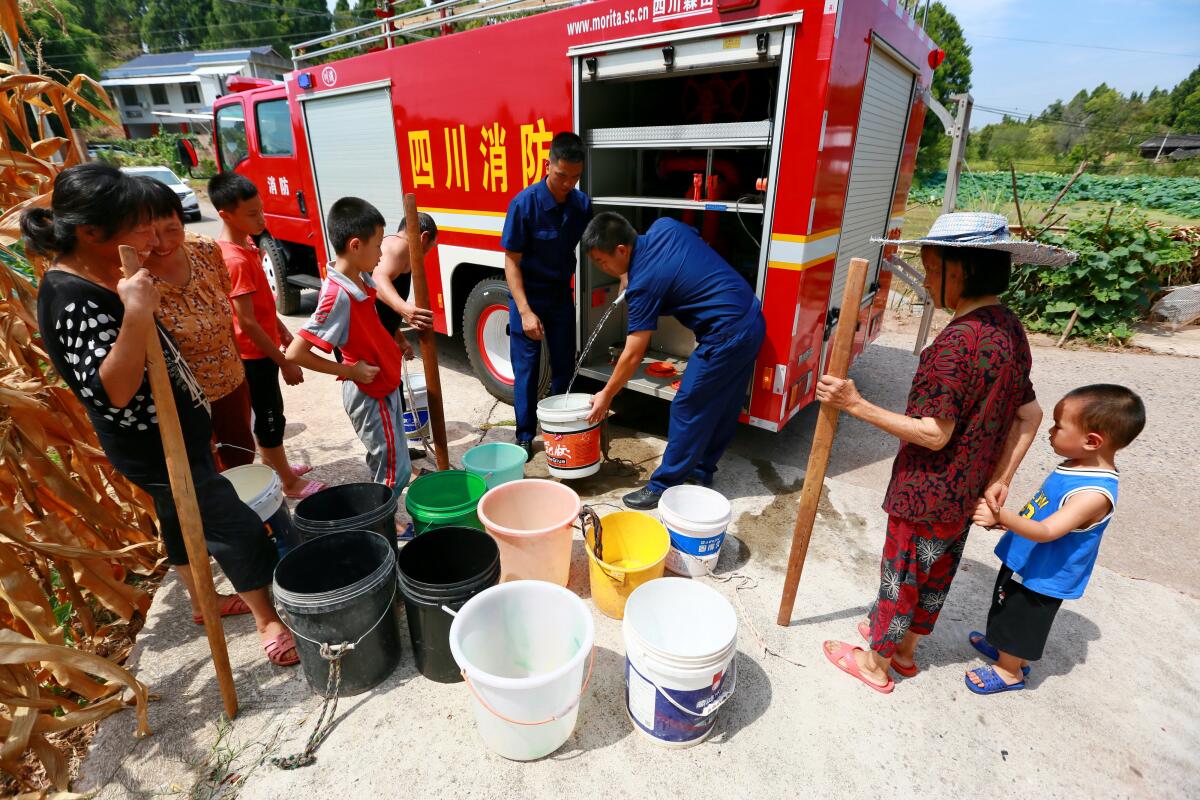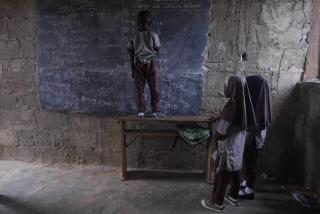China’s clean energy model staggers under drought: dying EV cars, blackouts

- Share via
TAIPEI, Taiwan — With 80% of its electricity coming from hydropower, the province of Sichuan in southern China has been lauded as a model for a clean energy future in the nation most crucial to the worldwide fight against climate change.
The province usually has such an abundance of power that it sends a surplus east to Shanghai and other cities.
But a historic drought is testing its faith in carbon-free energy. For much of August, lower river flows dramatically reduced the supply of electricity while a record heat wave increased demand.
The result: rolling blackouts that shut down factories and left millions of people desperate for ways to cool down.
Alva Zhou, a 23-year-old graduate student, was visiting her family in the city of Deyang when the power went out. Initially, they thought they might wait it out in their air-conditioned car.
But they soon realized the outage was nowhere near over and found a hotel with electricity. That was too expensive to do nightly, forcing the family back home, where the 104-degree heat made it difficult to sleep and the internet was often out.

“To all of a sudden halt power has a huge impact on life and work,” Zhou said. “There’s no way to go on.”
As the world strives to wean itself from fossil fuels to stave off the worst effects of climate change — including sea level rise, more severe storms and more frequent droughts — it has become clear that renewables have their own shortcomings. Transitioning to them as the planet continues to warm is far from painless.
The danger is that energy crunches like the one in Sichuan could push China — the world’s biggest emitter of heat-trapping greenhouse gases — to revert to burning more of its massive coal reserves. Other countries, most notably India, face the same temptation as their electricity demands grow.
Though the Chinese government has committed to ambitious carbon reductions, the turmoil from more power shortages is the last thing Chinese President Xi Jinping needs as he prepares to break precedent and begin a third five-year term.
“Any power cuts or limitations would create potential social instability. That’s what the Chinese government doesn’t want,” said Hongqiao Liu, a Paris-based energy policy consultant. “This Sichuan event really exposes all the bottlenecks in the current system.”
This summer’s drought and intense heat wave have killed crops and livestock, threatening the country’s food supply. Factories halted operations because of power cuts, further weighing on industrial output at a time of sluggish economic growth.
On Chinese social media, electric vehicle drivers complained of hourlong lines at charging stations. Office workers toiling away without air conditioning posted pictures of large ice blocks stationed around desks and in front of electric fans.
Others shared photos of small bottles of an herbal liquid, used in traditional Chinese medicine to alleviate the effects of summer heat.
More than 1,000 miles away, skyscrapers along Shanghai’s downtown waterfront went dark for two days too as a result of the power shortage in Sichuan.
“This really served as a wake-up call for policy makers that these traditional power planning models they’ve used in the past might be at risk,” said Cosimo Ries, an energy policy analyst at the research firm Trivium China. “What happened in Sichuan this year is a very clear example of this, not only for itself but also for the rest of China if climate change continues to intensify.”
The shortage also renewed debate on the dependability of renewables, and whether China would do better to invest in more coal rather than phase it out. Some analysts called for speeding up the energy transition, while others argued that the country should slow down.
China was responsible for about 33% of global emissions last year, compared with about 13% for the United States, the No. 2 emitter, according to the International Energy Agency.
But by some measures, China has been more aggressive in investing in clean energy and carbon reductions. It got 15% of its energy from renewables last year, ahead of the United States at 12%, and it reportedly has plans to more than double its wind and solar capacity by the end of 2025.
Analysts said China remains on track to meet its target to reach peak carbon emissions by 2030 and carbon neutrality by 2060.
But it still got 85% of its energy from fossil fuels last year, including 55% from coal, the dirtiest option.
Hydropower is not the only renewable energy source threatened by hotter climates, said Muyi Yang, senior Asia electricity policy analyst at the London-based energy think tank Ember. Extreme heat also tends to tamp down wind flows, and the effectiveness of solar panels drops when temperatures climb too high.
“Extreme weather is testing the resilience of power systems around the world,” Yang said. “The main commonality is that the clean power transition is not only about building more wind, solar and hydro. It’s really about rebuilding the whole power system.”
In California, the state’s power grid narrowly averted widespread outages last week during a blistering heat wave, after officials pleaded with residents to curb electricity usage. Europe’s worst drought in 500 years is hitting crop yields, exacerbating wildfire risks and weighing on hydropower generation.
Experts in China have proposed improving power storage and grid flexibility to allocate supply and manage demand in times of strain. Warning that extreme heat and power supply strains could become more commonplace, the government has increased financial assistance to power generators to boost reliability.
David Fishman, senior manager at the Hong Kong-based consultancy the Lantau Group, said improving China’s relatively nascent power grid may come easier than for countries with older, established systems. But until the infrastructure can accommodate such shocks, the system will remain at the mercy of the temperamental climate.
“It took an extreme weather event to expose that. You could say that it’s an outlier, but in this climate-changing world, is it really?” Fishman said. “All it would take is a return of the hot weather and you’d have problems again.”

By the end of China’s hottest August of all time, the dry spell gave way to heavy rains in Sichuan, spurring evacuations and warnings of mudslides and floods.
Zhou said she has long believed that climate change would get worse. But until this summer, her understanding largely came from social media and news reports, and her imagination concentrated on sinking coastal cities.
“This kind of situation had never happened before, so I think on climate change I’m becoming more pessimistic,” she said.
Though the electricity supply at Zhou’s home has returned to normal, she’s uncertain what other challenges extreme weather might bring.
Over two weeks of periodic power outages, she spent four nights in different hotel rooms with her parents and younger sister, in search of some relief from the heat.
During their second hotel visit, the electricity went out. With the elevator out of service, Zhou had to carry her mother, who was nursing a broken leg, down two flights of stairs.
Hotel rooms became scarcer and more expensive as more and more people sought refuge. Zhou and her family started visiting teahouses to cool down instead.
Finally, they found a more permanent solution to keep their air conditioners on at home: a small $200 generator powered by gasoline.
David Shen of The Times’ Taipei bureau contributed to this report.
More to Read
Sign up for Essential California
The most important California stories and recommendations in your inbox every morning.
You may occasionally receive promotional content from the Los Angeles Times.











